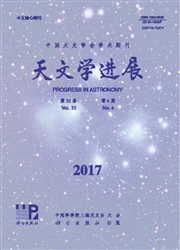

 中文摘要:
中文摘要:
近年来,随着用于高能量密度物理研究的实验装置如大功率激光器、磁力箍缩装置和托克马克等的发展,人们在实验室中可以使毫米尺度的物质达到极端高温、高压、高密度的状态,这使得在实验室环境中可以模拟天体物理环境中的物理条件及某些物理过程,从而推动了一个新兴科学领域——高能量密度实验室天体物理的发展。高能量密度实验室天体物理有很多重要的研究方向,包括超新星爆发过程中剧烈激波引发的非线性流体动力学不稳定性及其演化,原初恒星的喷流和高马赫数喷流,黑洞、中子星等致密天体周围的光致电离星风,不透明度的测量和天体磁场的重联现象等。在此选取高能量密度实验室天体物理中近年来几个研究方向的进展,对其进行系统地介绍,并对此领域的发展做出展单。
 英文摘要:
英文摘要:
Laboratory astrophysics is one of the youngest branches of astrophysics. Its name was coined about 30 years ago. It is successful because the physical laws we discover on Earth should work everywhere. We use laboratory experiments to expand our understanding of physical processes and then apply these results to the processes throughout the Universe. High energy density laboratory astrophysics (HEDLA) allows a depth study and comparison of the measurements produced by laboratory Z-pinches and lasers. In this paper, we review the recent progress in several fields of HEDLA, such as the supernova explosion, stellar jets, photoionized plasmas, stellar opacity and equation of state (EOS) and solar magnetic reconnection. In some cases laboratory experiments can reproduce similar physics. For example, the charged plasmas can be created in the laboratory to study the interactions among photons, electrons and ions that occur in the stars, the solar corona and the X-ray binaries. In other cases, we need some scales to study the processes behind the astrophysical phenomena by the experiments. For example, the evolution of a laboratory plasma jet, with typical spatial scales of a few mm and characteristic timescales of hundreds of ns, can be a scaled version of large-scale jets from young stars (typically thousands of astronomical units in length and evolving in timescales of many years). In order for this scaling to be valid, both the laboratory and astrophysical jets must have similar dimensionless parameters such as the Mach number, Reynolds number, and Peclet number. HEDLA is being paced by large experiments such as NIF, LMJ, and Shenguang lasers. New experimental techniques, improved simulations codes, and experimental diagnostics provide the ground-based testing which benefits our understanding of the Universe. The most powerful laser project is the National Ignition Facility (NIF), in which 196 laser beams deliver nearly 2 megajoules to a millimeter sized target, reproducing the plasma temperatures wi
 同期刊论文项目
同期刊论文项目
 同项目期刊论文
同项目期刊论文
 Investigation of the influence of inner-shell photoionization and photoexcitation on the He-alpha sp
Investigation of the influence of inner-shell photoionization and photoexcitation on the He-alpha sp 期刊信息
期刊信息
